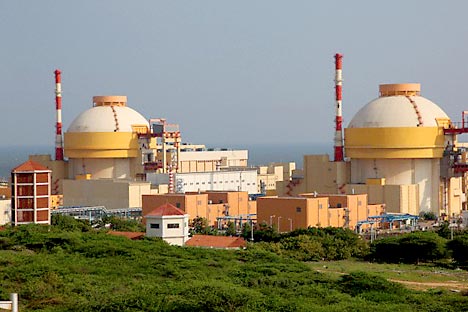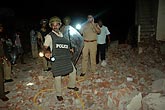Anti-KNPP protestors and threats to India’s national security

The Kudankulam plant is probably on the radar of many terrorist groups. Source: Corbis/Foto S.A.
On an evening when India quietly marked the 5th anniversary of the dreaded 26/11 terrorist attacks in Mumbai, six innocent people, including three children under the age of five lost their lives as a crude bomb went off in a colony housing tsunami survivors in a village close to Kudankulam. It’s obvious that the target of the bomb-makers wasn’t a small hut in a seaside village but something much grander in scale. It would be sheer lunacy to assume that the members of the protest group were targeting the plant, considering the fact that the first victims of such an attack would have been the protestors themselves. However, the fact that “innocent villagers,” as the NGOs call them, were busy making bombs only highlights the sheer desperation of those trying to halt further work on the Kudankulam Nuclear Power Plant (KNPP).
The Tamil Nadu Police have been quick to file a case against the ringleader of the “People’s Movement Against Nuclear Energy (PMANE),” S P Udayakumar. The latest reports indicate that one of the people injured in the blast and subsequently arrested is a member of PMANE; something that just seems to be too much of a coincidence at this point of time. It’s puzzling that Udayakumar has been roaming free ever since he became the face of the movement against the nuclear plant. The authorities in the southern Indian state were fully justified when they decided to charge those blocking the way to the plant with waging a war on the nation. This rag-tag group of activists, which seems to have powerful foreign backers, is probably just looking at intimidating the staff of the power plant as well as the local police and the state government. It may not necessarily be their intention to cause mass destruction but the same kind of terror groups that wrecked havoc in India’s financial capital will be monitoring these developments closely. The holes in security in the villages around the plant can easily be exploited by those looking at creating catastrophic destruction.
One of the targets for the Pakistani Air Force in the western front during the 1971 Bangladesh Liberation War was the Bhabha Atomic Research Centre in Trombay, which contained India’s first reactor and plutonium reprocessing facility. In 2013, rogue elements from across the border realise as an alternative to war, it is much easier to carry out a commando style terror attack like in Mumbai in 2008. Many argue that India’s western coastline is no safer five years after the audacious 26/11 attacks, which were by far the country’s worst intelligence failure.
Given the heavy police presence in and around Kudankulam, the fact that groups of villagers were making crude bombs in the area can also be considered an intelligence failure. The bigger question remains as to how safe the south-eastern coast is from a possible terror strike. Anni Nasheed, the former president of the Maldives warned India way back in 2009 that agents of the Lakshar-e-Tayaba, the group that carried out the Mumbai attacks were using uninhabited islands to plan potential attacks against India. Kudankulam is within striking distance of Kanyakumari, the southernmost point on the Indian mainland.
Related:

Tests continue at Kudankulam nuclear plant after second connection to grid
Level playing field essential for global nuclear power industry
The intelligence agencies are mainly focussing on the threat to the plant’s employees and their families at the moment, but it would be unwise to not keep larger threats in mind. A 26/11 style attack on the plant would have catastrophic consequences for all four states in southern India and the country as a whole. Terrorists could wreck more havoc on the plant than what nature managed to do to Fukushima. Although security has been temporarily stepped up around KNPP, permanent and strong measures are required to protect the plant from an attack from terrorist groups.
One should also keep in mind that there are some cadres of the Liberation Tigers of Tamil Eelam (LTTE) that managed to escape from Sri Lanka in the final days of the country’s civil war and are now in Tamil Nadu. PMANE’s Udayakumar was present at the inauguration of a monument dedicated to the Sri Lankan terrorist group near Thanjavur. It would not be difficult for PMANE to recruit LTTE cadres and involve them in the agitation against the KNPP. Such a scenario could only be termed as the worst possible security nightmare.
Tailpiece:
Five years after the most daring and audacious terror attacks that India ever witnessed, the country’s financial capital doesn’t look or feel any safer. Most of the metal detectors at Mumbai’s busy suburban railway stations don’t even work and the occasional meaningless ‘nakabandi’ or roadblock put up by the police in the city doesn’t seem to achieve anything. And with the attacks fading away ever so slowly from public memory and discourse, one can safely say that India, as a whole, has not learnt its lessons from 2008.
All rights reserved by Rossiyskaya Gazeta.
Subscribe
to our newsletter!
Get the week's best stories straight to your inbox
